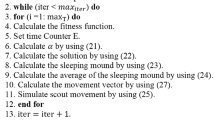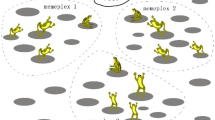Abstract
Parameter identification of bilinear systems has been considered as an evolutionary computing algorithm-based optimization problem in this paper. A new Levy shuffled frog leaping algorithm (LSFLA), which is an improved version of the conventional shuffled frog leaping algorithm (SFLA), has been designed and has been applied for this parameter identification task. LSFLA offers enhanced local search behaviour in comparison with other traditional evolutionary computing algorithms. The ability of the new algorithm in accurately modeling parameters in single input single output (SISO) as well as multiple input multiple output (MIMO) has been checked using an extensive simulation study. The parameter estimation efficiency of the new scheme has been compared with that obtained using other popular evolutionary computing algorithms and the simulation study reveals the enhanced parameter identification ability of the proposed LSFLA.








Similar content being viewed by others
References
Bruni C, Dipillo G, Koch G (1974) Bilinear systems: an appealing class of “nearly linear” systems in theory and applications. Autom Control IEEE Trans 19(4):334–348
Cho H, Olivera F, Guikema SD (2008) A derivation of the number of minima of the griewank function. Appl Math Comput 204(2):694–701
Das G, Pattnaik PK, Padhy SK (2014) Artificial neural network trained by particle swarm optimization for non-linear channel equalization. Expert Syst Appl 41(7):3491–3496
Ebrahimi J, Hosseinian SH, Gharehpetian GB (2011) Unit commitment problem solution using shuffled frog leaping algorithm. Power Syst IEEE Trans 26(2):573–581
Elbeltagi E, Hegazy T, Grierson D (2007) A modified shuffled frog-leaping optimization algorithm: applications to project management. Struct Infrastruct Eng 3(1):53–60
Eusuff M, Lansey K, Pasha F (2006) Shuffled frog-leaping algorithm: a memetic meta-heuristic for discrete optimization. Eng Optim 38(2):129–154
Eusuff MM, Lansey KE (2003) Optimization of water distribution network design using the shuffled frog leaping algorithm. J Water Resour Plan Manag 129(3):210–225
Huynh TH (2008) A modified shuffled frog leaping algorithm for optimal tuning of multivariable pid controllers. In: Industrial Technology. ICIT 2008. IEEE International Conference on, pp 1–6. IEEE
Kalouptsidis N, Koukoulas P, Mathews VJ (2003) Blind identification of bilinear systems. Signal Process IEEE Trans 51(2):484–499
Kar R, Mandal D, Mondal S, Ghoshal SP (2012) Craziness based particle swarm optimization algorithm for fir band stop filter design. Swarm Evol Comput 7:58–64
Kumar JV, Kumar D (2014) Generation bidding strategy in a pool based electricity market using shuffled frog leaping algorithm. Appl Soft Comput 21:407–414
Kuo SM, Wu HT (2005) Nonlinear adaptive bilinear filters for active noise control systems. IEEE Trans Circuits Syst I Regul Papers 52(3):617–624
Li X, Yin M (2015) A particle swarm inspired cuckoo search algorithm for real parameter optimization. Soft Comput:1–25
Luo J, Chen MR (2014) Improved shuffled frog leaping algorithm and its multi-phase model for multi-depot vehicle routing problem. Expert Syst Appl 41(5):2535–2545
Luo JP, Li X, Chen MR (2014) Hybrid shuffled frog leaping algorithm for energy-efficient dynamic consolidation of virtual machines in cloud data centers. Expert Syst Appl 41(13):5804–5816
Malik M, Ahsan F, Mohsin S (2014) Adaptive image denoising using cuckoo algorithm. Soft Comput:1–14
Mathews VJ, Sicuranza GL (2000) Polynomial signal processing. Wiley, New York
Modares H, Alfi A, Naghibi Sistani MB (2010) Parameter estimation of bilinear systems based on an adaptive particle swarm optimization. Eng Appl Artif Intell 23(7):1105–1111
Nanda SJ, Panda G, Majhi B (2010) Improved identification of hammerstein plants using new cpso and ipso algorithms. Expert Syst Appl 37(10):6818–6831
Niknam T, Azad Farsani E (2010) A hybrid self-adaptive particle swarm optimization and modified shuffled frog leaping algorithm for distribution feeder reconfiguration. Eng Appl Artif Intell 23(8):1340–1349
Ouaarab A, Ahiod B, Yang XS (2014) Random-key cuckoo search for the travelling salesman problem. Soft Comput 19(4):1099–1106
Ozer S, Zorlu H (2011) Identification of bilinear systems using differential evolution algorithm. Sadhana 36(3):281–292
Patwardhan AP, Patidar R, George NV (2014) On a cuckoo search optimization approach towards feedback system identification. Digital Signal Process. 32:156–163
Rahimi-Vahed A, Mirzaei AH (2007) A hybrid multi-objective shuffled frog-leaping algorithm for a mixed-model assembly line sequencing problem. Comput Ind Eng 53(4):642–666
Wang Z, Gu H (2007) Parameter identification of bilinear system based on genetic algorithm. In: Bio-Inspired Computational Intelligence and Applications, pp. 83–91. Springer, New York
Widrow B, Stearns SD (1985) Adapt Signal Process. Prentice-Hall, EngleWood Cliffs
Yang XS, Deb S (2009) Cuckoo search via levy flights. In: World Congress on Nature Biologically Inspired Computing, pp. 210–214
Acknowledgments
This work was supported by the Department of Science and Technology, Government of India under the INSPIRE Faculty Award Scheme (IFA-13 ENG-45).
Author information
Authors and Affiliations
Corresponding author
Ethics declarations
Conflict of interest
The authors declare that they have no potential conflict of interest.
Additional information
Communicated by V. Loia.
Rights and permissions
About this article
Cite this article
Kawaria, N., Patidar, R. & George, N.V. Parameter estimation of MIMO bilinear systems using a Levy shuffled frog leaping algorithm. Soft Comput 21, 3849–3858 (2017). https://doi.org/10.1007/s00500-016-2035-z
Published:
Issue Date:
DOI: https://doi.org/10.1007/s00500-016-2035-z




